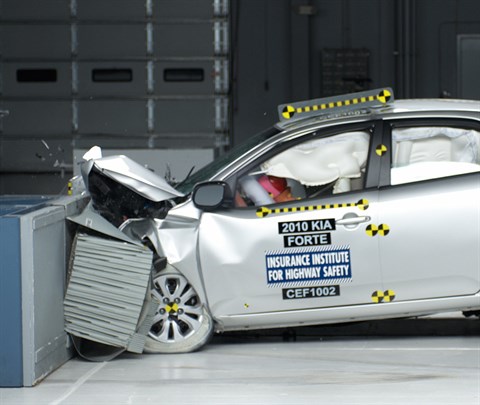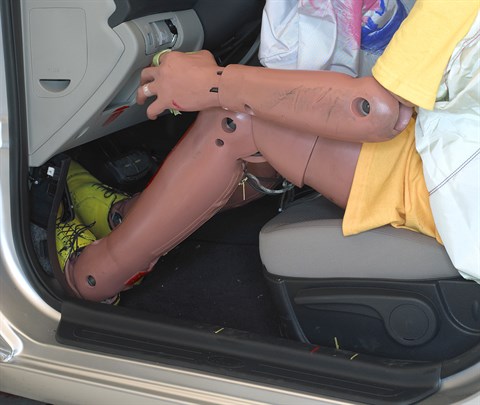Moderate overlap front: original test
Rating applies to 2010-13 models
Tested vehicle: 2010 Kia Forte EX 4-door
The Kia Forte was introduced in the 2010 model year as a replacement for the Kia Spectra.
Two tests of a 2010 Kia Forte were conducted. In the first test, forces recorded on the dummy's head and neck were high, leading to a Marginal head/neck injury rating and a Marginal overall rating. In response, Kia modified the airbag control computer to deploy the side curtain airbag, in addition to the frontal airbag, in certain frontal crashes beginning with cars manufactured after January 2010. Kia initiated a service campaign to reprogram the airbag control computer on all 2010 models produced before the change was made on the production line.
In the second test of a car built after the modifications were in place, the driver side curtain airbag deployed during the crash, and forces on the neck were low. However, forces on the head were still elevated.
The evaluation of the Forte is based on the second test, except for the structural rating, which is based both tests.
| Evaluation criteria | Rating |
|---|---|
| Overall evaluation | |
| Structure and safety cage | |
| Driver injury measures | |
| Head/neck | |
| Chest | |
| Leg/foot, left | |
| Leg/foot, right | |
| Driver restraints and dummy kinematics | |

Action shot taken during the second of two frontal offset crash tests.

The dummy's position in relation to the steering wheel and instrument panel after the crash test indicates that the driver's survival space was maintained well (second test shown).

In both tests, forces on the head were high when the dummy's head hit the steering wheel through the frontal airbag (second test shown).

Intrusion into the driver's space was minimal, and all leg and foot injury measures were low (second test shown).
Measures of occupant compartment intrusion on driver side
| Evaluation criteria | Measurement | |
|---|---|---|
| Test ID | CEF0912 | CEF1002 |
| Footwell intrusion | ||
| Footrest (cm) | 6 | 7 |
| Left (cm) | 9 | 9 |
| Center (cm) | 7 | 8 |
| Right (cm) | 5 | 7 |
| Brake pedal (cm) | 10 | 9 |
| Instrument panel rearward movement | ||
| Left (cm) | 2 | 1 |
| Right (cm) | 3 | 1 |
| Steering column movement | ||
| Upward (cm) | 1 | 3 |
| Rearward (cm) | -4 | -4 |
| A-pillar rearward movement (cm) | 1 | 1 |
Driver injury measures
| Evaluation criteria | Measurement | |
|---|---|---|
| Test ID | CEF1002 | |
| Head | ||
| HIC-15 | 670 | |
| Peak gs at hard contact | 114 | |
| Neck | ||
| Tension (kN) | 1.0 | |
| Extension bending moment (Nm) | 13 | |
| Maximum Nij | 0.71 | |
| Chest maximum compression (mm) | 29 | |
| Legs | ||
| Femur force - left (kN) | 0.8 | |
| Femur force - right (kN) | 3.1 | |
| Knee displacement - left (mm) | 0 | |
| Knee displacement - right (mm) | 6 | |
| Maximum tibia index - left | 0.41 | |
| Maximum tibia index - right | 0.65 | |
| Tibia axial force - left (kN) | 1.4 | |
| Tibia axial force - right (kN) | 2.8 | |
| Foot acceleration (g) | ||
| Left | 61 | |
| Right | 50 | |
Side: original test
Rating applies to 2011-13 models
Tested vehicle: 2010 Kia Forte EX 4-door with standard front and rear head curtain airbags and standard front seat-mounted torso airbags
The Kia Forte was introduced in the 2010 model year as a replacement for the Kia Spectra. Beginning with 2011 models, Kia made design changes to the side curtain airbags and side structure to improve occupant protection in side impact crashes. Side ratings are assigned by the Institute based on a test conducted by Kia. The car tested was a 2010 model that incorporated all the design changes included in the 2011 models.
| Evaluation criteria | Rating |
|---|---|
| Overall evaluation | |
| Structure and safety cage | |
| Driver injury measures | |
| Head/neck | |
| Torso | |
| Pelvis/leg | |
| Driver head protection | |
| Rear passenger injury measures | |
| Head/neck | |
| Torso | |
| Pelvis/leg | |
| Rear passenger head protection | |
Measures of occupant compartment intrusion on driver side
| Test ID | VTS1006 |
|---|---|
| B-pillar to longitudinal centerline of driver's seat (cm) | -9.0 |
| Negative numbers indicate the amount by which the crush stopped short of the seat centerline. | |
Driver injury measures
| Evaluation criteria | Measurement |
|---|---|
| Test ID | VTS1006 |
| Head HIC-15 | 254 |
| Neck | |
| Tension (kN) | 1.0 |
| Compression (kN) | 0.6 |
| Shoulder | |
| Lateral deflection (mm) | 25 |
| Lateral force (kN) | 1.2 |
| Torso | |
| Maximum deflection (mm) | 37 |
| Average deflection (mm) | 29 |
| Maximum deflection rate (m/s) | 2.87 |
| Maximum viscous criterion (m/s) | 0.45 |
| Pelvis | |
| Iliac force (kN) | 2.3 |
| Acetabulum force (kN) | 2.5 |
| Combined force (kN) | 4.7 |
| Left femur | |
| L-M force (kN) | 1.2 |
| L-M moment (Nm) | 193 |
| A-P moment (Nm) | 69 |
Passenger injury measures
| Evaluation criteria | Measurement |
|---|---|
| Test ID | VTS1006 |
| Head HIC-15 | 304 |
| Neck | |
| Tension (kN) | 0.5 |
| Compression (kN) | 1.3 |
| Shoulder | |
| Lateral deflection (mm) | 41 |
| Lateral force (kN) | 1.5 |
| Torso | |
| Maximum deflection (mm) | 37 |
| Average deflection (mm) | 31 |
| Maximum deflection rate (m/s) | 4.53 |
| Maximum viscous criterion (m/s) | 0.59 |
| Pelvis | |
| Iliac force (kN) | 0.5 |
| Acetabulum force (kN) | 0.2 |
| Combined force (kN) | 0.9 |
| Left femur | |
| L-M force (kN) | 2.7 |
| L-M moment (Nm) | 284 |
| A-P moment (Nm) | 80 |
Roof strength
Rating applies to 2010-13 models built after October 2009
Tested vehicle: 2010 Kia Forte SX 4-door
| Overall evaluation | |
|---|---|
| Curb weight | 2,859 lbs |
| Peak force | 13,084 lbs |
| Strength-to-weight ratio | 4.58 |
Head restraints & seats
Seat type: Manual cloth seats AHR
| Overall evaluation | |
|---|---|
| Dynamic rating | |
| Seat/head restraint geometry |
| Seat type | Manual cloth seats AHR |
|---|---|
| Geometry | |
| Backset (mm) | 30 |
| Distance below top of head (mm) | 3 |
| Seat design parameters | |
| Pass/fail | Pass |
| Max T1 acceleration (g) | 10.7 |
| Head contact time (ms) | 55 |
| Force rating | 1 |
| Neck forces | |
| Max neck shear force (N) | 19 |
| Max neck tension (N) | 231 |
About the head restraint & seat test
Currently, IIHS tests apply only to front seats.
